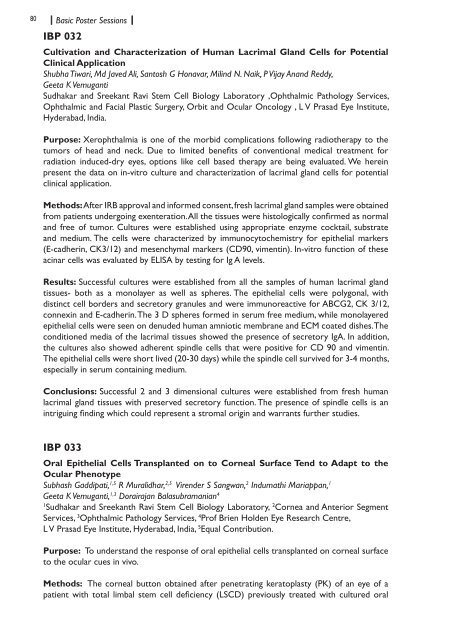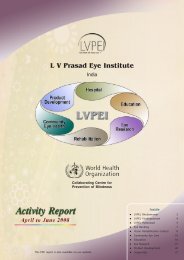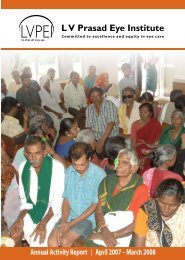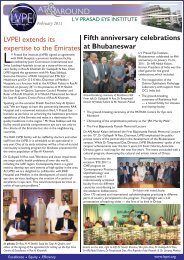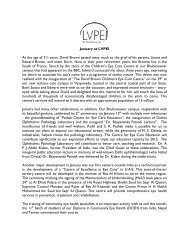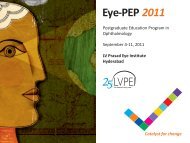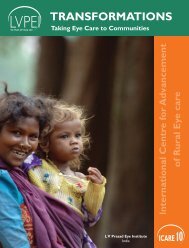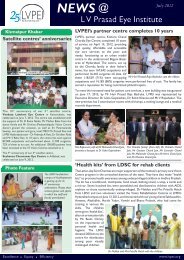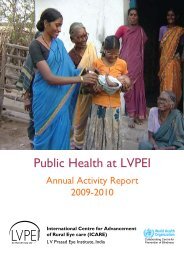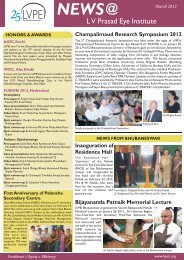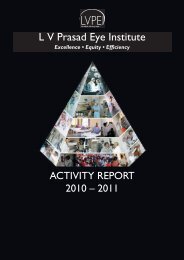IERG Abstracrt Book.indd - LV Prasad Eye Institute
IERG Abstracrt Book.indd - LV Prasad Eye Institute
IERG Abstracrt Book.indd - LV Prasad Eye Institute
Create successful ePaper yourself
Turn your PDF publications into a flip-book with our unique Google optimized e-Paper software.
80 Basic Poster SessionsIBP 032Cultivation and Characterization of Human Lacrimal Gland Cells for PotentialClinical ApplicationShubha Tiwari, Md Javed Ali, Santosh G Honavar, Milind N. Naik, P Vijay Anand Reddy,Geeta K VemugantiSudhakar and Sreekant Ravi Stem Cell Biology Laboratory ,Ophthalmic Pathology Services,Ophthalmic and Facial Plastic Surgery, Orbit and Ocular Oncology , L V <strong>Prasad</strong> <strong>Eye</strong> <strong>Institute</strong>,Hyderabad, India.Purpose: Xerophthalmia is one of the morbid complications following radiotherapy to thetumors of head and neck. Due to limited benefits of conventional medical treatment forradiation induced-dry eyes, options like cell based therapy are being evaluated. We hereinpresent the data on in-vitro culture and characterization of lacrimal gland cells for potentialclinical application.Methods: After IRB approval and informed consent, fresh lacrimal gland samples were obtainedfrom patients undergoing exenteration. All the tissues were histologically confirmed as normaland free of tumor. Cultures were established using appropriate enzyme cocktail, substrateand medium. The cells were characterized by immunocytochemistry for epithelial markers(E-cadherin, CK3/12) and mesenchymal markers (CD90, vimentin). In-vitro function of theseacinar cells was evaluated by ELISA by testing for Ig A levels.Results: Successful cultures were established from all the samples of human lacrimal glandtissues- both as a monolayer as well as spheres. The epithelial cells were polygonal, withdistinct cell borders and secretory granules and were immunoreactive for ABCG2, CK 3/12,connexin and E-cadherin. The 3 D spheres formed in serum free medium, while monolayeredepithelial cells were seen on denuded human amniotic membrane and ECM coated dishes. Theconditioned media of the lacrimal tissues showed the presence of secretory IgA. In addition,the cultures also showed adherent spindle cells that were positive for CD 90 and vimentin.The epithelial cells were short lived (20-30 days) while the spindle cell survived for 3-4 months,especially in serum containing medium.Conclusions: Successful 2 and 3 dimensional cultures were established from fresh humanlacrimal gland tissues with preserved secretory function. The presence of spindle cells is anintriguing finding which could represent a stromal origin and warrants further studies.IBP 033Oral Epithelial Cells Transplanted on to Corneal Surface Tend to Adapt to theOcular PhenotypeSubhash Gaddipati, 1,5 R Muralidhar, 2,5 Virender S Sangwan, 2 Indumathi Mariappan, 1Geeta K Vemuganti, 1,3 Dorairajan Balasubramanian 41Sudhakar and Sreekanth Ravi Stem Cell Biology Laboratory, 2 Cornea and Anterior SegmentServices, 3 Ophthalmic Pathology Services, 4 Prof Brien Holden <strong>Eye</strong> Research Centre,L V <strong>Prasad</strong> <strong>Eye</strong> <strong>Institute</strong>, Hyderabad, India, 5 Equal Contribution.Purpose: To understand the response of oral epithelial cells transplanted on corneal surfaceto the ocular cues in vivo.Methods: The corneal button obtained after penetrating keratoplasty (PK) of an eye of apatient with total limbal stem cell deficiency (LSCD) previously treated with cultured oral


